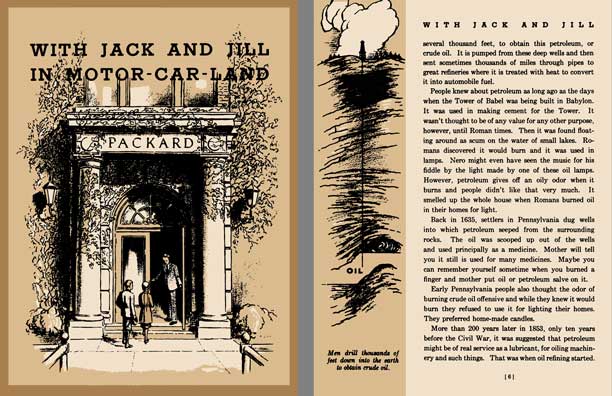Packard 1933 - With Jack and Jill in Motor-Car-Land - The Story of the Motor Car as Told by

36 page all new reprint; digitally restored from the original source and printed on high quality 8.5" x 11", 32#, 97 bright acid free paper in Color, assembled into an individual item that is folded and stapled, or heat bonded with an adhesive fabric binding.
Contents - Index:
- Pages: 36
- Packard 1933 - With Jack and Jill in Motor-Car-Land - The Story of the Motor Car as Told by the Packard Man to Jack and Jill his Sister Jill
- Packard Motor Car Co
- 1899 - 1933 Packard Motor Company
- Illustrations
- The Story of the Motor Car
- Chapter I: First We Had to Have Gasoline
- Glaciers of the Ice Age helped bury the materials form which petroleum was made. Illustration
- Many layers formed a lid for the cooking that gave the world gasoline. Illustration
- Men drill thousands of feet down into the earth to obtain crude oil. Illustration
- Gasoline once thought useless. It was hauled out to sea and dumped. Illustration
- Chapter II: The Grandfathers of Automobiles
- The first automobile had a boiler like a kettle. Illustration
- James Watt studied his mother's tea kettle and discovered the power of steam. Illustration
- An electric spark is the match which sets fire to the mixture of gasoline and air. Illustration
- A boy on a bicycle might represent a two cylinder engine. Each leg is a connecting rod. Illustration
- Chapter III: Engines Breathe Just Like People
- This illustrates how an engine breathes in air and gasoline vapor. Illustration
- Everything hurries in a motor. The crankshaft often revolves 4000 times a minute. Illustration
- Electric switches in a motor frequently click on and off 24,000 times a minute. Illustration
- Electricity has to have a clear road back home before it will venture out. Illustration
- The Packard Chassis and Relation of its Operating Units to Each Other. Illustration
- The starter uses electricity from the battery to set the motor of an automobile running. Illustration
- In Packard cars oil is sprayed on cylinder walls, greatly reducing wear. Illustration
- An automobile motor has what might be called a brain, nerves, nose, lungs and heart. Illustration
- The principle of the clutch. Illustration
- Chapter IV: How Power Goes to the Wheels
- This illustrates the principle of the automobile transmission gears. Illustration
- The differential subtracts speed from one wheel and add it to the other. Illustration
- Brakes shoes are forced tightly against inside rims of iron and steel drums, causing friction which stops the car. Illustration
- The Packard radiator lines of today, refined and beautified by characteristically Packard. Illustration
- Packard uses scientific instruments to diagnose service problems. Illustration
- Chapter V: Elephants and Cars Go Together
- Elephants and Packards go together in many Rajahs garages. Illustration
- Eighty one trades are represented in the mile long Packard factory. Illustration
- Packard engines in Gar Wood's Miss America X are three times as powerful as a modern passenger locomotive. They develop 6100 HP. Illustration
- A fly's weight bends a steel bar one millionth of an inch. Illustration
- We, better than anyone else, can keep your Packard perfect. Illustration
- If we have overlooked anything you'd like to know, please write us. Illustration
- Ask the Man Who Owns One
